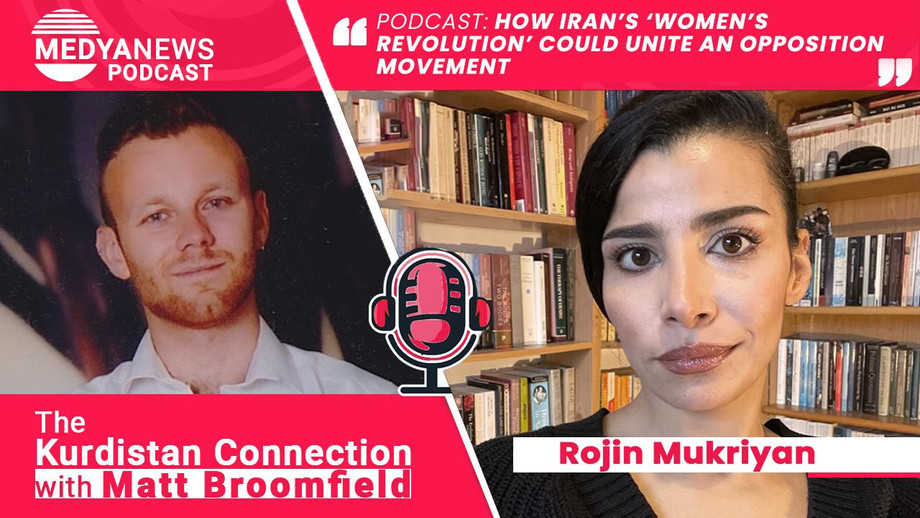Matt Broomfield speaks to Rojin Mukriyan, a female Kurdish academic and member of the diplomacy committee of Iran’s Kurdistan Free Life Party (PJAK), to learn how Iran's women's revolution could have a lasting impact by uniting an opposition movement.
One year on from Jina Mahsa Amini’s death, her name has been heard around the world. Following the young Kurdish women’s fatal beating by the Iranian morality police, uprisings led by Kurdish women and united under the Kurdish slogan ‘Jin, Jiyan, Azadi’ (‘Woman, Life, Freedom’) spread from Rojhilat (Iranian Kurdistan) throughout Iran.
But although Kurdish women’s struggle in Iran received unprecedented global attention, much analysis wrote Kurdish women out of the picture, treated Iran’s exiled royal family as the main hope for the Iranian opposition, and failed to understand the realities on the ground. Meanwhile, hundreds of protesters have been killed, and women in Iran are still being harassed and targeted by the morality police.
To mark the 16 September anniversary, Medya News spoke to Rojin Mukriyan, a female Kurdish academic and member of the diplomacy committee of Iran’s Kurdistan Free Life Party (PJAK), to learn more. She characterised the uprisings in Rojhilat as a ‘women’s revolution’, and pointed to ongoing efforts by Iranian Kurdish parties to organise joint mass strikes and potentially reach out to other opposition groups as evidence of the uprising’s lasting impact.
Edited highlights follow, and you can watch the full conversation above.
To what extent can the 2022 uprisings in Rojhilat be characterised as a women-led revolution?
To understand what this revolutionary movement was, and is, and what its effect was on the society of Iran, you should understand that we’re talking about a social movement: a bottom-up movement, that strives to bring fundamental change within the existing system, and all spheres of life. To change mentality, culture, society, economy, and at the end – politics.
It’s a bottom-up movement, and at the end change starts from society. Many men are now shoulder-by-shoulder with women, men who live in a very patriarchal society, standing and chanting ‘Jin, Jiyan, Azadi’. They’re not opposed to the idea of women’s liberation at all, but actually promote the idea. In this sense, a lot has changed.
It also creates a revolutionary culture among people. We see now, for example, that burial and funeral ceremonies have turned into an area for political demonstration. We see the mothers of martyrs killed by the Iranian regime: they don’t mourn their kids as passive victims anymore, but chant ‘martyrs never die’. This culture of revolution moved beyond Rojhilat, into other Persian cities. The mothers do the same.
Were there leaders or organisations trying to give direction to this social movement?
It was a grassroots movement. There wasn’t any leader in Iran or Rojhilat formally organising this movement. But if we refer back to all the evidence we have from September 2022 through to January 2023, we recognize a structure within the protests. For example, every Saturday there was a public strike, and the protesters were not gathering in one place or one city… each people gathered in their own neighbourhoods in the evening, occupying the streets, and forming a fortress of resistance, in an informal mode of organisation.
To mark the anniversary, six Iranian Kurdish parties have united to call for a general strike. What’s the significance of this step?
So far, we can distinguish between different oppositions; one is the far-right, nationalist opposition led by Reza Pahlavi [son of the deposed monarch]; we have another opposition that hasn’t formed yet, which we can call the left democratic and libertarian opposition. The precondition to form this [broader] coalition, is firstly coalition between Kurdish political parties in Rojhilat. This revolutionary movement started in Kurdistan, and the Kurdish people were leading this movement. As we saw in other parts of Iran, like Tehran, they were listening to what the Kurdish people were doing, and saying that if Iran became like Kurdistan, all Iran could turn into heaven.
Can this coalition prove a stepping-stone for a broader political movement, reaching out to other opposition forces in Iran?
In early June, we had a conference in the European Parliament composed of the representatives of all the national minorities of Iran, and many Persian leftists. In that conference, I realised there’s a very shared understanding of what the issue is. We all felt a shared oppression, and this may have the potential to unite these national minorities. I’m optimistic, but I would like to be realistic. We see the challenges…
So far, we have basically the same understanding of what the problem is, and I think this can help us to reach one solution as well.


